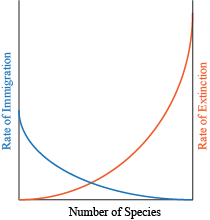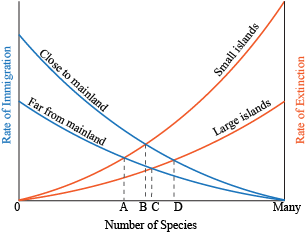Describe the Theory of Island Biography
Once you are there open the Background Information link. For an island biodiversity is a measure of the number of different species that live on an island called species richness and the number of.

Geogongolland 在 Twitter 上 4 The Equilibrium Theory Of Island Biogeography Ask Students To Consider Factors Affecting Number Of Species On Islands Why Is It Important For Conservationists Problematise The Theory
A single theory to explain diversity based on island area isolation and turnover.

. The book popularized the theory that insular biota maintain a. Reminded Remington and Grant of a fundamental theory in ecology. The equilibrium theory of island biogeography is one attempt to explain this situation.
As more species colonize island there are fewer new ones on the continent. The second is that islands. As a biological island these are separated by different ecosystems and this leads to specification in species.
What are the two major processes that determine the equilibrium number of species in an area. The theory of island equilibrium theory of island biogeography has biogeography has been one of the more been one of the more influential concepts in important products of island studies. Hypotheses developed early on based on island biogeography offered a theoretical framework to understand how fragmentation would influence population viability and persistence in terrestrial.
Hooker explored islands in the South Atlantic and South Pacific. Two ecologists Robert MacArthur and EO. The theory of island biogeography states that the number of species found on a particular undisturbed island is determined solely by the number of species immigrating to the island and by extinction rates.
The theory of island biogeography states that a larger island will have a greater number of species than a smaller island. Theory of Island Biogeography Activity We will use the Theory of Island Biogeography simulation to understand how species might come to be present in places they never were before. The Theory of Island Biogeography is a 1967 book by the ecologist Robert MacArthur and the biologist Edward O.
The theory of island biogeography. The Theory of Island Biogeography Island biogeography has been a subject of considerable interest to biologists and geographers since the time of Darwin Wallace and the less well-known Hooker. Modern biogeography ecology and evolutionary Eugene G.
Write a summary of the text in 5-10 words 2. The theory of island biogeography states that the larger islands have a greater number of species. Write a follow up question about the content on the page Page 5.
C Imagine that you were trying to set up some protected areas to save alpine meadow communities. For the purposes of this theory an island is any ecosystem that is. Number of species on small islands can only increase through immigration or colonization - too small for speciation.
Island biogeography theory also led to the development of wildlife corridors as a conservation tool to increase connectivity between habitat islands. National Parks in the History of Science. Munroe 1948 1953 first biology.
Size and isolation of islands. For instance in most of the eastern United States only patches of the once-great deciduous forest remain and many species of songbirds are disappearing from those patches. The Equilibrium Theory of Island Biogeography 1.
The Theory of Island Biogeography. The number of different species present in an ecosystem and relative abundance of each of those species. It is widely regarded as a seminal piece in island biogeography and ecologyThe Princeton University Press reprinted the book in 2001 as a part of the Princeton Landmarks in Biology series.
The three biogeographic islands in America are Santa Catalina California Kauai Hawaii and block island in Rhodes. Go to the Theory of Island Biogeography simulation by clicking HERE. -the number of species ranges from 0-1 species saturation point -immigration rate decreases.
Fifty years ago mangrove islands in Everglades National Park were the subject of a now-famous experiment that tested an important idea about biodiversity. The theory of island biogeography postulates that species richness in isolated habitats is regulated by local extinction and colonization and should vary with habitat size and proximity to potential sources of colonizers. More species exist on island means greater chance to.
Island biogeographic theory has been applied to many kinds of problems including forecasting faunal changes caused by fragmenting previously continuous habitat. Using your text first define the following. A Describe the equilibrium theory of island biogeography in your own words.
The Equilibrium Theory of Island Biogeography. The theory also states that isolated species may follow evolutionary routes that are different than species on land masses that are not isolated. 9 minutes 36 seconds.
Answer to Solved a Describe the equilibrium theory of island. Meet the scientist who conducted it. The theory of Island Bio geography attests that species on islands while derived from common ancestors evolved to become unique species in isolation.
The biogeography and ecology. Island Biogeography Island biogeography is a theory that attempts to explain the factors that affect the biodiversity of biological communities on islands. In this video we go over the equilibrium theory of island biogeography.
Visit our keyboard shortcuts docs for details Duration. The Siberian tiger for example migrated from the Northern Siberian region across terrestrial landscapes. Wilson proposed that the number of animal species on an island reflects a balance between colonization extinction rates and the actual size of the island itself.
Its ancestors included the North American bobcat and other big cats across the Bering Strait. Concepts of habitat fragmentation emerged from the expansion of theories of island biogeography MacArthur and Wilson 1967. The first predicts that larger islands will have higher biodiversity because there are more resources and space to support more wildlife than smaller areas.
MacArthur and Wilson use the example of a new volcanic island to explain their theory. This theory has two components. Equilibrium Theory of Island Biogeography ETIB The ETIB describes the theoretical relationship between immigration and extinction of species to islands depending on their size and distance from the mainland or other species source.

Theory Of Island Biogeography Youtube

Island Equilibrium Theory A Model Download Scientific Diagram

Island Biogeography Theory And Examples Biology Dictionary

Macarthur And Wilson Equilibrium Theory Of Island Biogeography And Download Scientific Diagram

The Theory Of Island Biogeography And Speciation Rate A The Number Download Scientific Diagram

The Mechanistic Approach Of The Theory Of Island Biogeography And Its Current Relevance Sciencedirect

Ecology Does Island Biogeography Theory Accurately Explain The Number Of Species Native To Hawaii What About Other Islands Quora

Biogeography Island Biogeography Shmoop

The Model Of Theory Of Island Biogeography Macarthur And Wilson 1967 Download Scientific Diagram

Equilibrium Theory Of Island Biogeography Biogeography Youtube

Theory Of Island Biogeography Download Scientific Diagram

Island Biogeography Conservationbytes Com

Natural Laboratories In Perspective A Review Of Literature On Theories Of Island Biogeography Routes

Biogeography Island Biogeography Shmoop

Island Biogeography Theory States That The Number Of Species On An Island Is Determined By Immigration Rates Of New Species To The Island And Extincti Sarthaks Econnect Largest Online Education Community




Comments
Post a Comment